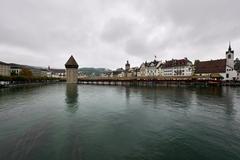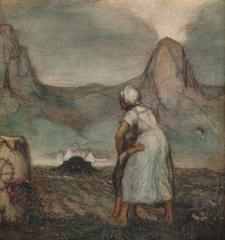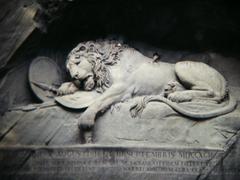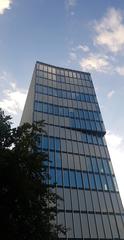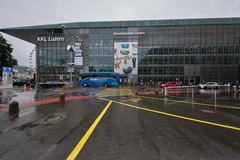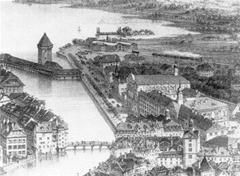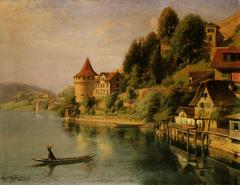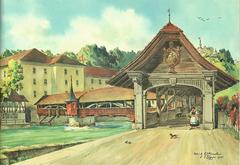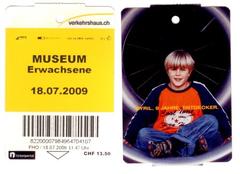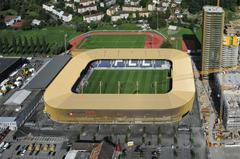
Bourbaki Panorama Lucerne: Visiting Hours, Tickets, and Historical Significance
Date: 03/07/2025
Introduction
Located in the heart of Lucerne, Switzerland, the Bourbaki Panorama is a remarkable fusion of art, history, and humanitarian legacy. This monumental 19th-century panoramic painting, created in 1881 by Édouard Castres—a Swiss artist and Red Cross volunteer—transports visitors to the winter of 1871, when 87,000 French soldiers sought refuge in neutral Switzerland during the Franco-Prussian War. Measuring 112 meters in circumference and 10 meters in height, the panorama immerses viewers in a 360-degree visual narrative, commemorating Switzerland’s humanitarian response and neutrality. This comprehensive guide details everything you need to plan your visit, including Bourbaki Panorama visiting hours, ticketing, accessibility, guided tours, and nearby attractions (Bourbaki Panorama Official, MySwitzerland).
Table of Contents
- Introduction
- Origins and Creation
- Historical Context: The Franco-Prussian War and Swiss Neutrality
- Artistic and Technical Achievement
- Humanitarian Significance and Legacy
- Restoration and Preservation
- Visiting Information
- Guided Tours and Special Events
- Nearby Attractions
- Visuals and Media
- Frequently Asked Questions (FAQ)
- Conclusion & Visitor Recommendations
- Sources and Further Reading
Origins and Creation of the Bourbaki Panorama
The Bourbaki Panorama stands as a monumental testament to artistic innovation and humanitarian history. Painted in 1881 by Édouard Castres, who witnessed the depicted events firsthand, the panorama was completed with the help of a talented team including Ferdinand Hodler. The painting envelops visitors in a 360-degree visual story, capturing the internment of the French Army of the East—known as the Bourbaki Army—who crossed into Switzerland to escape annihilation at the end of the Franco-Prussian War (Bourbaki Panorama Official).
This unprecedented humanitarian event involved the disarmament, shelter, and care of tens of thousands of French soldiers by Swiss communities, the army, and the Red Cross. The panorama’s narrative blends historical reality with deep empathy for the suffering and relief efforts of the time (Bourbaki Panorama Jahresprogramm 2025, p.2).
Historical Context: The Franco-Prussian War and Swiss Neutrality
The Franco-Prussian War (1870–1871) marked a turning point in European history. After defeat and encirclement, the French Army of the East, led by General Bourbaki, sought asylum in Switzerland during the harsh winter of 1871. Switzerland’s acceptance of the army was a defining moment, requiring unprecedented mobilization and coordination. This episode reinforced Switzerland’s role as a humanitarian nation and established practical precedents for the Geneva Conventions and the Red Cross (Bourbaki Panorama Official).
Artistic and Technical Achievement
Panoramic paintings were a popular 19th-century entertainment form, offering immersive, lifelike experiences before the advent of cinema. The Bourbaki Panorama achieves this through advanced perspective, lighting, and composition, enhanced further by three-dimensional elements and artifacts. Visitors stand on a central platform, surrounded by the vast canvas, with life-sized mannequins and a recreated railway boxcar seamlessly blending into the painting (lucerne.all-about-switzerland.info; touringswitzerland.com).
The panorama was originally displayed in a purpose-built rotunda in Geneva and moved to Lucerne in 1889, where it remains an architectural and artistic landmark (Bourbaki Panorama Jahresprogramm 2025, p.2).
Humanitarian Significance and Legacy
The internment of the Bourbaki Army is a landmark in humanitarian history. Switzerland’s neutral and compassionate response set new standards for the treatment of refugees and prisoners of war. The involvement of the Red Cross—founded just years prior—demonstrated principles that would shape international humanitarian law. The painting honors not only the soldiers and relief workers but also the many Swiss civilians and women whose efforts were crucial (Bourbaki Panorama Jahresprogramm 2025, p.2).
Restoration and Preservation
The panorama has been restored multiple times, most notably between 1996 and 2003, with further updates to the faux terrain in 2008 (touringswitzerland.com). Its survival is rare; most 19th-century panoramas have not endured, highlighting the importance of ongoing conservation (myswitzerland.com).
Visiting Information
Location and Accessibility
- Address: Löwenplatz 11, 6000 Lucerne, Switzerland
- Accessibility: Fully wheelchair accessible, with ramps, elevators, and accessible restrooms (holidify.com).
- Getting There: Walking distance from Lucerne’s main train station; accessible by city buses; nearby parking available, though public transport is recommended.
Visiting Hours
- April–October: Daily, 10:00–18:00
- November–March: Daily, 10:00–17:00
- Closed on major public holidays. Always check the official website for updates.
Ticket Prices
- Adults: CHF 12–15
- Seniors, students, military: CHF 10–12
- Children (6–16): CHF 7 (under 6 free)
- Family and group rates available
- Discounts for Swiss Museum Pass, Lucerne Museum Card, Swiss Travel Pass, and Raiffeisen members (bourbakipanorama.ch; nomads-travel-guide.com)
Tickets can be purchased on-site or booked online.
Travel Tips
- Plan for 1–1.5 hours to visit.
- Early mornings and weekdays are quieter.
- Combine with nearby Lucerne attractions for a full day.
Guided Tours and Special Events
- Guided Tours: Offered in multiple languages; book in advance for groups (bourbakipanorama.ch).
- Thematic Tours: Led by historians or restorers on request.
- Interactive App: “My Bourbaki Panorama” app offers stories and puzzles for all ages (luzern.com).
Museum Exhibits and Visitor Amenities
- Museum: Interactive displays, artifacts, and personal stories enrich the historical context (myswitzerland.com).
- Audio Guides: Available in several languages.
- Bourbaki Bistro: On-site café for refreshments.
- Bourbaki Kino: In-house cinema screening international and Swiss films.
- Gift Shop: Souvenirs, books, and educational materials available.
Nearby Attractions in Lucerne
- Chapel Bridge (Kapellbrücke): Iconic covered bridge.
- Lion Monument: Commemorates Swiss Guards.
- Old Town: Medieval streets and architecture.
- Swiss Museum of Transport: Interactive exhibits on Swiss travel history.
Visuals and Interactive Media
- High-resolution images and virtual tours available on the official website.
- Bourbaki Panorama interior view.
Frequently Asked Questions (FAQ)
Q: What are the Bourbaki Panorama visiting hours?
A: April–October: 10:00–18:00; November–March: 10:00–17:00. Check the official website for updates.
Q: How much do tickets cost?
A: Adults CHF 12–15; discounts for seniors, students, and groups. Children under 6 free.
Q: Is the panorama wheelchair accessible?
A: Yes, with full access and facilities for those with reduced mobility.
Q: Are guided tours available?
A: Yes, in multiple languages, including thematic tours—book ahead for groups.
Q: Can I take photos inside the panorama?
A: Non-flash photography is generally allowed; check with staff for details.
Conclusion & Visitor Recommendations
The Bourbaki Panorama offers a unique and moving journey into a pivotal chapter of European history. Its immersive art, historical depth, and humanitarian message make it essential for visitors seeking to understand Switzerland’s cultural and social identity. With accessible facilities, guided tours, and proximity to other Lucerne attractions, it is an enriching and memorable destination. Enhance your visit by downloading the Audiala app for audio guides, and consult the official website for the latest information on exhibitions, events, and ticketing (MySwitzerland).
Call to Action:
Download the Audiala app for interactive audio guides and visitor updates. Follow Bourbaki Panorama on social media for current events, and explore Lucerne’s rich historical offerings for a truly rewarding Swiss experience.
Sources and Further Reading
- Bourbaki Panorama Official Website
- MySwitzerland.com: Bourbaki Panorama
- TouringSwitzerland.com: Bourbaki Panorama Luzern
- Lucerne All About Switzerland Info: Bourbaki Panorama Painting Castres
- Swissinfo: Bourbaki Panorama – A Monumental Painting of War and Peace
- Historical Dictionary of Switzerland: Bourbaki Army Internment
- Red Cross Museum: Bourbaki Panorama Lucerne
- Swiss Heritage Society: Bourbaki Panorama Conservation
- Federal Office of Civil Protection: Cultural Property of National Significance
- European Route of Industrial Heritage: Bourbaki Panorama
- Holidify.com: Bourbaki Panorama Lucerne Sightseeing
- Nomads Travel Guide: Bourbaki Panorama



